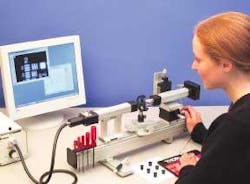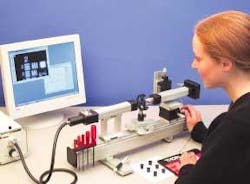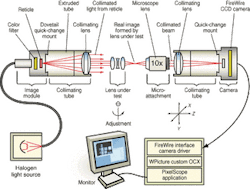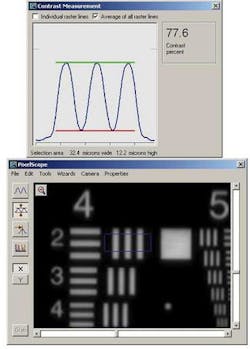Lens-testing system links multiple optics
Optical test system interconnects off-the-shelf optics components to provide both qualitative and quantitative measurements of lens performance.
By Lawrence J. Curran, Contributing Editor
Consultant Ben Wells has advised many clients on the use of off-the-shelf optics assemblies in the development of complex machine-vision systems. He points out that commercial optics assemblies are made in high volume and can be a bargain if they do the required job. But these lenses are seldom optimized for OEM tasks, and Wells recommends that clients perform up-front testing to verify that the lenses fit the application.
Wells is founder and president of Wells Research and Development (Lincoln, MA, USA), a consulting company specializing in optics and precision-measurement equipment. A major company product is OpticStudio, an entry-level optical test system that provides both qualitative and quantitative measurements of lens performance. Wells developed the system in cooperation with Thorlabs Inc. (Newton, NJ, USA). The system is manufactured by Thorlabs and is available as model OS100 (see photo).
Wells' career includes engineering and management experience at Polaroid Corp., Teradyne Inc., and Reflection Technology. His work at those companies convinced him of the need for affordable and easy-to-use optical testing equipment. "I've seen too many people build complex optical systems without first thinking through the testing issues," says Wells. "I wanted to give clients a way to measure critical imaging components before committing to a specific implementation."
Wells describes OpticStudio as "fast, intuitive to use, and, at $11,000, less expensive than other optical-testing systems on the market." Production-line testers range from $30,000 to $50,000. His goal was to enable new users to "walk up to the system, drop in a lens, and make measurements."
System integration
The key elements of OpticStudio/OS100 include a 200-mm-focal-length collimated image source; a holder for the lens under test (LUT); and a video microscope (see Fig. 1 on p. 17). The optics components are mounted on an extruded 1-m-long optical rail. The microscope is carried on a three-axis adjustable mount, and the lens can be rotated about the nodal point for off-axis testing. This system also incorporates PixelScope image-analysis software developed by Wells Research. This software, which runs under Windows 2000 or XP, displays real-time video images on a 1-GHz or faster PC.
FIGURE 1. To test a lens, light from a source (left) is carried over optical fiber to the collimator and then through a color filter and reticle. The lens under test (LUT) forms a real image of the image from the collimator reticle, but a few inches farther along the optical rail. The reduced real image formed by the LUT is magnified by the microscope lens. The magnified image is projected onto the CCD camera (right) and transmitted via a FireWire link to the PC for image processing.
The collimator section starts with a Thorlabs high-intensity halogen light source manufactured by StockerYale Inc. (Salem, NH, USA). A 3-ft-long fiberoptic cable carries light to the condenser section of the collimator, which includes interchangeable reticles and color filters from Thorlabs. The collimator lens is a key component because wavefront error in the test beam must be minimized.
Such errors would make it difficult to detect subtle errors in the LUT. "I've seen people use catalog achromats for this purpose, but they are not nearly good enough," says Wells. "You need better than a
1/10 wave." Kreischer Optics Ltd. (McHenry, IL, USA) was selected to make the custom collimator lenses.
When users "drop in a lens for test," says Well, it is held in a self-centering lens mount that can be rotated for measuring off-axis points in the image. The LUT forms a real image of the image from the collimator reticle, but a few inches farther along the optical rail.
If the LUT is of high quality, the image will be a replica of the reticle image, blurred only by unavoidable diffraction effects caused by the wave nature of light. Such a lens is said to be "diffraction limited." Less-sophisticated lenses, or lenses with fabrication errors, can display characteristic image flaws, such as spherical aberration and chromatic aberration. OpticStudio can measure these flaws.
A high-power video microscope is used to view the image produced by the LUT. The microscope section consists of a microscope lens, collimator tube, and CCD camera. The microscope lens is "infinity compensated," Wells says, so it requires a secondary tube lens. In the OS100 microscope, this lens is the same 25-mm-diameter lens used in the collimators. "This is a bit of overkill when used as a microscope," says Wells, "but it allows a user to quickly convert the video microscope into a video telescope just by removing the microscope lens." This allows so-called afocal systems, such as binoculars and beam expanders, to be tested on the system. This flexibility was a design goal of the OpticStudio line, says Wells.
The microscope lens is another key optical component. A 10X lens from Olympus America Inc. (Melville NY, USA) was selected, based on performance tests. "This lens is designed for biological applications, and we were warned that we would need a cover glass," says Wells. "But testing (on an OS100) showed that the lens performed well without one. Because of high-volume production, the lens is reasonably priced."
The image finally reaches the CCD, the sensor of a FireWire video camera. This chip, from Sony America Inc. (Park Ridge, NJ, USA), features 640 × 480-pixel resolution, progressive scanning, and square pixels. The camera PC board is supplied by Point Grey Research Inc. (Vancouver BC, Canada). Thorlabs integrates these components and supplies the necessary software for interfacing the camera to an IEEE 1394 (FireWire) port on the PC. A PCI card is also supplied in case the computer is not equipped with an IEEE 1394 port.
Software contribution
After the camera captures the image from the LUT, the software "back end" of OpticStudio comes into play. Wells Research PixelScope software provides a suite of measurements appropriate to lens testing. Basic capabilities include viewing magnified images in real time, as well as cross-section plots.
"You can tell a great deal about a lens by visual evaluation of image quality," says Wells, who adds that reproducible numeric measurements are usually needed. While there are myriad ways to measure image quality, Wells says that clients often set go/no-go specifications in terms of contrast at some specific spatial resolution. This contrast is measured with a three-bar target, such as the USAF-1951 target supplied with OS100. The targets are manufactured on semiconductor mask-making equipment by Advance Reproductions Corp. (North Andover, MA, USA).
Other measurements include focal length, back focal length, magnification, and a list of parameters of interest to optical engineers. For example, PixelScope plots the modulation transfer function (MTF) based on the image of a narrow line or a simple edge. MTF is a measurement of lens quality that plots a lens' ability to resolve smaller and smaller details.
To make a test measurement, the operator uses the computer mouse to drag a selection rectangle around a feature on the screen and then presses a key for the appropriate "tool" mode (see Fig. 2). The result is plotted in real time.
FIGURE 2. Main screen window shows live video of a USAF three-bar target for making a contrast measurement (top). Second window shows the plot in which the results are displayed (bottom). The operator has dragged a "(blue) selection rectangle" around the feature of interest. To measure the contrast of target 2 in group 4, the operator presses the "contrast" tool icon, which opens the plot window, displays the numerical result (77.6%), and shows the underlying data.
Wells says the recent availability of OEM FireWire cameras is a boon to small system developers. "Previously, we used NTSC cameras that required a frame grabber card. We had used cards from several vendors and had good luck when we installed them in new computers. But there were enough disastrous driver/system interactions so that we insisted on supplying a computer with each test system. This allows us to avoid driver conflicts, but it also means we have to supply computers, which we didn't want to do," adds Wells.
To interface to the low-level camera driver, Wells evaluated software packages from various OEM camera suppliers, as well as packages from third-party OCX vendors he had previously used. "We needed the ability to pan, zoom, draw regions of interest, and capture binary image data, all while displaying live video on the monitor. We wanted to do this in a way that would encapsulate all the 'messy' threading issues away from the image-analysis code." Eventually, Wells decided to develop his own OCX component to perform these functions.
Cost control
Wells' experience exposed him to three strategies for optical testing: buy professional production test equipment, build home-brew test setups, and build the machine and hope for the best. His experience leads him to recommend the first option: "The hidden costs in the latter two strategies are always underestimated," he contends.
However, Wells' experience also showed him how difficult it is to justify expensive equipment in a startup environment. "At more than one job I ended up building home-brew equipment because I couldn't convince my boss to spend $30,000 for a single test station. As a consultant, I found that clients faced the same dilemma; they wanted to build simple setups." That led to his packaging of OpticStudio as a commercial product.
He chose Thorlabs to manufacture the system after evaluating a number of prospective partners. Thorlabs builds the system, including metal extrusions, using skills acquired as a provider of optical prototyping equipment. "Thorlabs specializes in manufacturing competitively priced building blocks, ranging from optomechanical components to telecom test instrumentation. OpticStudio was a natural addition to its line of products," Wells says.
Company Info
Advance Reproductions Corp. www.advancerepro.com
Kreischer Optics Ltd. www.kreischer.com
Olympus America Inc. www.olympusamerica.com
Point Grey Research Inc. www.ptgrey.com
Sine Patterns LLC www.sinepatterns.com
Sony Electronics Inc. www.sony.com/videocameras
StockerYale Inc. www.stockeryale.com
Thorlabs Inc. www.thorlabs.com
Wells Research and Development www.wellsresearch.com



